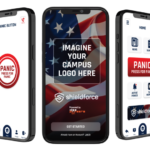The results of Campus Safety’s new Emergency Communications Survey have been tabulated. While in past years, CS has conducted separate surveys on emergency notification and panic alarms/mobile duress systems, recent technological advances have prompted the combining of these two topics into one survey this year.

To download the free 2025 Campus Safety Emergency Communications Survey Charts & Participant Comments, CLICK HERE.
Traditionally, mass notification/emergency alert technology has been mostly limited to one-way communications where the public safety or security department broadcasts a message — often via SMS text alert, audio announcement, digital signage text and/or other methods — notifying the campus about a safety or security issue. Recently, however, many manufacturers of emergency notification systems have expanded the functionality of their technologies to include two-way communications so message recipients can also convey information about an emergency back to the public safety/security department.
A significant number of Emergency Communications Survey respondents are embracing this advance in technology. Forty-four percent of respondents say their emergency notification systems support silent, two-way communications with staff, administrators and first responders, compared to 38% of respondents who said their systems don’t support two-way communications.
Additionally, some panic alarm systems — which traditionally provided only one-way communications from a staff member experiencing a crisis to campus public safety — now allow campus public safety/security officers to communicate back to the person initiating the panic alarm.
Furthermore, we’re seeing more integration of emergency notification systems with panic alarm/mobile duress systems. Nearly one in five (19%) survey takers said some (16%) or all (3%) of their mass notification/alert systems integrate with their panic alarms/mobile/wearable duress pendants.
Read on to learn about the frequency of alert system activations and panic button usage, which systems campuses are considering upgrading in the near future, performance issues and more.
91% of Campuses Use Email for Emergency Communications
Email notifications, text message (SMS) alerts, and intercom/overhead paging systems are the most popular emergency communications systems used by this year’s survey takers. More than nine out of ten respondents (91%) use emails for mass notification, 86% have text alert solutions and 74% have intercoms/overhead paging.
However, when broken down by sector, colleges and universities are more likely to use SMS text alerts (94%) compared to only 80% of K-12 school and 84% of healthcare respondents. Conversely, at 92%, K-12 and hospital respondents are much more likely to use intercoms/overhead paging systems than institutions of higher education (52%).
More than two in three respondents (67%) use external loudspeakers. However, at 88%, K-12 schools and school districts are much more reliant on this type of technology than colleges and universities (52%) and healthcare (39%).
Fixed panic buttons are in use by 61% of survey respondents, but when broken down by sector, the rate of usage varies significantly. Nearly all healthcare respondents say their organizations use fixed panic buttons, compared to 70% of colleges and universities and 52% of K-12 campuses.
Fire systems with voice evacuation follow, with 58% of respondents saying they use these systems.
Participants Most Interested in Acquiring or Upgrading Pop-up Alerts, Fixed Panic Buttons, Digital Signage
Nearly two in five survey participants (39%) expressed interest in acquiring pop-up alerts on computers and projectors, with 14% saying they already have this type of system in place but are considering upgrades in the next two years. One in four (25%) don’t have computer pop-up alerts but are considering acquiring this type of system soon.
Interest in fixed panic buttons is also strong at 37%, followed by digital displays/signage or scrolling message boards at 36%, and mobile/wearable duress/panic buttons at 35%.
At 41%, interest in future purchases or upgrades of fixed panic alarms is highest among higher education survey participants, followed by healthcare at 39%, and K-12 schools at 33%. Respondents from colleges and universities also expressed the most interest in purchasing digital displays/signage or scrolling message boards: 41%, compared to only 33% for K-12 schools/school districts, and 32% for healthcare.
Healthcare was by far the sector most interested in mobile/wearable duress/panic buttons at 59%, compared to 35% of K-12 and 30% of higher education respondents.
Reasons for Emergency Communications System Upgrades and New Purchases Vary
At 36%, “Upgrading our system will provide additional features that are critical to safety and security” was the most popular reason cited by respondents for why they recently purchased or plan to purchase an emergency notification system in the near future.
However, only 7% of respondents with panic alarm/mobile duress systems indicated the need for additional features was a motivation for them. This is rather surprising. Fixed panic buttons/alarm systems on campuses, which are the most common panic alarm technologies installed, often are old. Last year’s panic alarm survey found that 60% of respondents who indicated they have fixed panic buttons said the system they have is 5 years old or older.
For panic alarms, the most common motivation for a purchase or upgrade was financial: 24% of respondents said, “Upgrading our system will save us money and/or other resources in the long run.”
A significant portion of respondents said their only motivation was to do a better job of protecting their organization. “Nothing in particular. We just want to improve safety and security on campus” was the motivation for 22% of respondents who bought emergency notification systems and 17% of participants who bought panic alarms.
Recent incidents that happened in other parts of the country” prompted 18% to buy new or upgraded alert solutions and 16% to acquire panic alarm systems.
Old equipment or equipment that doesn’t work was the motivation for 16% of emergency notification and 14% of panic alarm system purchases/upgrades.
Unfortunately, 10% and 12% respectively know that an emergency notification and/or panic alarm system would improve safety and security, but their campuses aren’t taking any steps to acquire a system.
SMS Text Alerts Receive Highest Performance Rating
Survey participants were asked to rate the performance of the systems they use, and CS ranked their responses on a scale from one to five, with one being “poor” and five being “excellent.”
With a score of 4.35, text message (SMS) alerts sent to mobile phones came out on top, with 47% of respondents rating this technology as excellent and 41% rating it as good. At 4.25, email emergency/mass notifications came in second, with 86% rating their system as excellent (41%) or good (45%). Fire systems with voice evac came in third, with a score of 4.06 and 75% of respondents rating this technology as excellent (34%) or good (41%).
It should be noted that most respondents are quite pleased with their emergency communications systems:
- 76% rated as excellent or good their mobile apps for emergency alerts, mobile/wearable duress/panic buttons, and sirens.
- 75% rated their panic alarm apps and digital displays/signage or scrolling message boards as excellent or good
- 73% rated their fixed panic buttons as excellent or good
External loudspeakers and phone trees received the worst performance rating of 3.67 and 3.7, respectively. Only about 60% of survey takers rated these systems’ performance as excellent or good.
More Than 1 in 2 Respondents Use Email for Alerts at Least Once a Week
More than two in five (41%) respondents send out or initiate emergency notifications at least once per month: 31% monthly, 6% weekly, and 4% daily.
These figures echo last year’s survey findings when we asked participants how often they use specific types of emergency notification or mass notification systems.
Last year experienced a big increase in email usage: 52% of all 2024 respondents said they use their email system for emergency notifications every week, several times per week, or daily. That was a 12-point increase over 2022. Both outdoor audible mass notifications and social media notifications saw 11% increases in usage compared to two years before.
Frequency of Panic Alarm Usage Depends on Campus Type
Mobile panic buttons on pendants are the panic alarm systems used/activated most frequently by respondents. One in five organizations (21%) that have this type of technology said in last year’s panic alarm survey that they use it daily, 10% use it weekly, and 20% use it monthly.
However, when broken down by sector, hospitals use their fixed panic buttons and mobile/wearable panic alarms on pendants much more frequently. Half say their organizations use these technologies daily or weekly. This is understandable considering the extremely high rate of workplace violence that happens at hospitals.
When healthcare respondents are removed from the response data, 12% of K-12 campuses and 15% of institutions of higher education use their fixed panic buttons daily or weekly. Most schools and colleges that have this type of system activate it monthly or a few times per year.
Schools and institutions of higher education also use their mobile duress pendants less than hospitals, with 16% of educational campuses using them daily or weekly. More than half of K-12 and higher ed respondents (52%) say their organizations use their mobile duress pendants monthly or a few times per year.
Usage of mobile phone apps for panic alarms is similar among K-12 schools, colleges, and healthcare facilities, with 18% saying they use this technology daily or weekly. Over half (55%) use it monthly or a few times per year.
2 in 5 Campuses Allow All Employees to Carry Mobile Panic Buttons
Of the survey participants whose organizations have panic alarm/mobile/wearable duress buttons or apps, 40% allow all their employees to carry these devices. However, a significant minority (28% overall but much higher at universities and in healthcare) indicated a wide variety of other positions, departments, or roles are allowed to carry panic buttons. The most common “other” role was security and safety staff members, followed by devices being given on a “case by case” basis or “as needed.” Human resources was mentioned, as were reception desks/secretaries, high risk areas, research facilities and child care areas.
When broken down by sector, 59% of K-12 respondents said that all their employees are allowed to carry mobile/wearable duress pendants. Not surprisingly, at 36%, medical staff are the employees in healthcare who are most likely to be authorized to carry panic buttons at their organizations. At colleges and universities, “only top administrators and executives” was the most popular selection at 23%.
Survey Participants Share Lessons They’ve Learned
The 2025 Campus Safety Emergency Communications Survey asked survey respondents to also provide comments on the successes and challenges they’ve experienced with their emergency notification solutions and panic alarms systems, as well as any advice they wanted to share with other campus protection professionals. They didn’t hold back. Here are the lessons some of them have learned:
- Have good policies in place to track changes such as new employees that used to be notified but were not added to the list to be notified. Also, when people move around the school district, their area of notification is updated.
- Previous security team provided wireless panic buttons to hundreds of employees. Recent audit found that batteries had not been regularly replaced, buttons could not be found and users had moved and did not update location. We are using an app for employees and students and restricting use of wired panic buttons to cashiers and other high security areas.
- All systems/Apps need to be integrated for seamless redundant activation.
- We tried initiating an announcement on the Public Address system and there were no results. Documented periodic test cable checks must be conducted by a stand-by in-house trained technical team. Currently, we are seeking to purchase a state-of-the-art system that is addressable and capable of integrating fire alarms and mass notification/ public. address.
- In the last few years, our college expanded our campus by buying existing adjacent properties. The properties had their own security systems, and so far none of those systems are compatible with our main campus system. We also have several emergency telephones throughout campus that are now monitored by the county sheriff because our campus is small and we do not have our own 911 dispatchers and our local town disbanded the city law enforcement department. Another challenge is we do not use a standard system to control a lockdown on campus. Every building has its own unique locking system. Some have keys to lock up, and other buildings have an electronic swipe card to lock up- and we do not have a set of master keys in order to lock down the campus
- Accidental activations are occurring too often. In most of these incidents, employees have left the emergency badge in their back pocket or in a chair and sat on the badge activating a lockdown or other level of alert. ADVICE: Tell all employees to never put a wearable alert badge in their paints pocket or leave one laying in a chair!
- The human factor is still an issue, and it requires care in crafting and reviewing messaging before things are sent.
To read about survey participant successes and challenges with mass notification and panic alarm systems, CLICK HERE to download the full report.
Campus Safety thanks the more than 250 school, university and healthcare protection professionals who participated in this study and provided their feedback. We truly appreciate your input!
Sponsored by:














